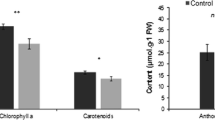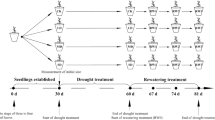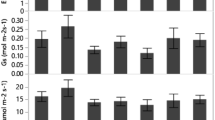Abstract
To assess the potential of short-term screenings for drought resistance at the seedling stage to detect ecotypic variation and predict field performance, we studied the responses to water deficit of seedlings of Pinus canariensis from five geographic origins under controlled conditions and compared these responses with the performance of provenances in a multi-site field trial. Leaf water potential, the osmotic component, leaf chlorophyll fluorescence and growth and biomass partitioning were measured as seedlings were subjected for 11 days to two levels of osmotic potential generated by polyethylene glycol (PEG 6000), −1 MPa (slowly imposed water deficit; S) and −1.5 MPa (fast imposed water deficit; F), and a control treatment (no PEG added to the nutrient solution; C). Leaf water potential declined to final mean values of −1.2, −2.7 and −4.7 MPa in the C, S and F treatments, respectively. The ratio of variable to maximum chlorophyll fluorescence declined to final mean values of 0.77, 0.66 and 0.40 in the C, S and F treatments, respectively, with no differences amongst provenances. All provenances showed an active osmotic adjustment (OA) in response to water deficit which varied depending on the drying rate. A slow imposition of water deficit favoured solute accumulation. Pooling all treatments, the index of OA ranged from 0.28 to 0.40, but rose considerably when only C and S treatments were considered (0.56 to 0.70). There was a positive and significant correlation between the overall index of OA (all treatments pooled) and the drought period in the site of origin, suggesting ecotypic variation in OA as a result of drought duration. Seedlings allocated more dry matter to roots than shoots when subjected to moderate and slowly imposed water deficit; only one provenance showed no increase in the root to shoot ratio at the end of the treatment period compared with control seedlings. Responses to controlled water deficits were only qualitatively related to performance (survival and growth) of provenances in several field sites, indicating the involvement of complex mechanisms to cope with drought under natural conditions. However, the provenance with the highest overall index of OA outgrew and outsurvived the other provenances in the most arid site, and the only provenance not modifying the root to shoot ratio in response to water deficit survived the least in all field sites. Acclimation of root to shoot ratio and net solute accumulation to water deficit could hence favour drought-tolerance beyond the seedling stage and be used as preliminary predictors of field performance.





Similar content being viewed by others
References
Atzmon N, Moshe Y, Schiller G (2004) Ecophysiological response to severe drought in Pinus halepensis Mill. Trees of two provenances. Plant Ecol 171:15–22. doi:10.1023/B:VEGE.0000029371.44518.38
Baquedano FJ, Castillo FJ (2006) Comparative ecophysiological effects of drought on seedlings of the Mediterranean water-saver Pinus halepensis and water-spenders Quercus coccifera and Quercus ilex. Trees Struct Funct 20:689–700
Baquedano FJ, Castillo FJ (2007) Drought tolerance in the Mediterranean species Quercus coccifera, Quercus ilex, Pinus halepensis, and Juniperus phoenicea. Photosynthetica 45:229–238. doi:10.1007/s11099-007-0037-x
Bloom AJ, Chapin FS, Mooney HA (1985) Resource limitation in plants-an economic analogy. Annu Rev Ecol Evol Syst 16:363–392
Bradshaw AD (1965) Evolutionary significance of phenotypic plasticity in plants. Adv Genet 13:115–155. doi:10.1016/S0065-2660(08)60048-6
Calamassi R, Della Rocca G, Falusi M, Paoletti E, Strati S (2001) Resistance to water stress in seedlings of eight European provenances of Pinus halepensis Mill. Ann For Sci 58:663–672. doi:10.1051/forest:2001153
Chazen O, Hartung W, Neumann PM (1995) The different effects of PEG 6000 and NaCl on leaf development are associated with differential inhibition of root water transport. Plant Cell Environ 18:727–735. doi:10.1111/j.1365-3040.1995.tb00575.x
Clifford SC, Arndt SK, Corlett JE, Joshi S, Sankhla N, Popp M, Jones HG (1998) The role of solute accumulation, osmotic adjustment and changes in cell wall elasticity in drought tolerance in Ziziphus mauritiana (Lamk). J Exp Bot 49:967–977. doi:10.1093/jexbot/49.323.967
Climent J, Chambel MR, López R, Mutke S, Alía R, Gil L (2006) Population divergence for heteroblasty in the Canary Island pine (Pinus canariensis, Pinaceae). Am J Bot 93:840–848. doi:10.3732/ajb.93.6.840
Cochard H, Coll L, Le Roux X, Ameglio T (2002) Unraveling the effects of plant hydraulics on stomatal closure during water stress in walnut. Plant Physiol 128:282–290. doi:10.1104/pp.128.1.282
Comstock J, Ehleringer J (1984) Photosynthetic responses to slowly decreasing leaf water potentials in Encelia frutescens. Oecologia 61:241–248. doi:10.1007/BF00396767
Cregg BM, Zhang JW (2001) Physiology and morphology of Pinus sylvestris seedlings from diverse sources under cyclic drought stress. For Ecol Manage 154:131–139
Di Castri F, Goodall DW, Specht RL (1981) Ecosystems of the world 11. Mediterranean-type shrub lands. Elsevier, Amsterdam
Dichio B, Xiloyannis C, Sofo A, Montanaro G (2006) Osmotic regulation in leaves and roots of olive trees during a water deficit and rewatering. Tree Physiol 26:179–185
Epron D, Dreyer E (1996) Starch and soluble carbohydrates in leaves of water-stressed oak saplings. Ann For Sci 53:263–268. doi:10.1051/forest:19960209
Epron D, Dreyer E, Breda N (1992) Photosynthesis of oak trees (Quercus petraea (Matt) Liebl) during drought under field conditions—diurnal course of net CO2 assimilation and photochemical efficiency of photosystem-II. Plant Cell Environ 15:809–820. doi:10.1111/j.1365-3040.1992.tb02148.x
Fan S, Blake TJ (1997) Comparison of polyethylene glycol 3350 induced osmotic stress and soil drying for drought simulation in three woody species. Trees Struct Funct 11:342–348
Fan S, Blake TJ, Blumwald E (1994) The relative contribution of elastic and osmotic adjustments to turgor maintenance of woody species. Physiol Plant 90:408–413. doi:10.1111/j.1399-3054.1994.tb00406.x
Fernández M, Gil L, Pardos JA (1999) Response of Pinus pinaster Ait. Provenances at early age to water supply. I. Water relation parameters. Ann For Sci 56:179–187. doi:10.1051/forest:19990209
Flexas J, Ribas-Carbo M, Bota J, Galmes J, Henkle M, Martinez-Canellas S, Medrano H (2006) Decreased Rubisco activity during water stress is not induced by decreased relative water content but related to conditions of low stomatal conductance and chloroplast CO2 concentration. New Phytol 172:73–82. doi:10.1111/j.1469-8137.2006.01794.x
Gibeaut DM, Hulett J, Cramer GR, Seemann JR (1997) Maximal biomass of Arabidopsis thaliana using a simple, low-maintenance hydroponic method and favorable environmental conditions. Plant Physiol 115:317–319. doi:10.1104/pp.115.2.317
Gieger T, Leuschner C (2004) Altitudinal change in needle water relations of Pinus canariensis and possible evidence of a drought-induced alpine timberline on Mt. Teide, Tenerife. Flora 199:100–109
Hsiao TC, Acevedo E, Fereres E, Henderson DW (1976) Stress metabolism: water stress, growth, and osmotic adjustment. Philos Trans R Soc Lond Sev B 273:479–500. doi:10.1098/rstb.1976.0026
Jiménez MS, Luis VC, Peters J, González-Rodríguez AM, Morales D (2005) Ecophysiological studies on Pinus canariensis. Phyton Ann Rei Bot A 45:169–177
Jones MM, Rawson HM (1979) Influence of rate of development of leaf water deficit upon photosynthesis, leaf conductance, water use efficiency, and osmotic potential in sorghum. Physiol Plant 45:103–111. doi:10.1111/j.1399-3054.1979.tb01672.x
Jones MM, Turner NC (1980) Osmotic adjustment in expanding and fully expanded leaves of sunflower in response to water deficits. Aust J Plant Physiol 7:181–192
Kozlowski TT, Pallardy SG (2002) Acclimation and adaptive responses of woody plants to environmental stresses. Bot Rev 68:270–334. doi:10.1663/0006-8101(2002)068[0270:AAAROW]2.0.CO;2
Lee CS, Kim JH, Yi H, You YH (2004) Seedling establishment and regeneration of Korean red pine (Pinus densiflora S. et Z.) forest in Korea in relation to soil moisture. For Ecol Manage 199:423–432
Lilley JM, Ludlow MM (1996) Expression of osmotic adjustment and dehydration tolerance in diverse rice lines. Field Crops Res 48:185–197. doi:10.1016/S0378-4290(96)00045-7
López R, Zehavi A, Climent J, Gil L (2007) Contrasting ecotypic differentiation for growth and survival in Pinus canariensis. Aust J Bot 55:759–769. doi:10.1071/BT07016
Ma QF, Turner DW, Levy D, Cowling WA (2004) Solute accumulation and osmotic adjustment in leaves of Brassica oilseeds in response to soil water deficit. Aust J Agric Res 55:939–945. doi:10.1071/AR03183
Martínez-Ferri E, Balaguer L, Valladares F, Chico JM, Manrique E (2000) Energy dissipation in drought-avoiding and drought-tolerant tree species at midday during the Mediterranean summer. Tree Physiol 20:131–138
Maxwell K, Johnson GN (2000) Chlorophyll fluorescence—a practical guide. J Exp Bot 51:659–668. doi:10.1093/jexbot/51.345.659
Mediavilla S, Escudero A (2004) Stomatal responses to drought of mature trees and seedlings of two co-occurring Mediterranean oaks. For Ecol Manage 187:281–294
Morgan JM (1992) Osmotic components and properties associated with genotype differences in osmoregulation in wheat. Aust J Plant Physiol 19:67–76
Morgan JM, Rodríguez-Maribona B, Knights EJ (1991) Adaptation to water-deficit in chickpea breeding lines by osmoregulation: relationship to grain-yields in the field. Field Crops Res 27:61–70. doi:10.1016/0378-4290(91)90022-N
Munns R (1988) Why measure osmotic adjustment? Aust J Plant Physiol 15:717–726
Nguyen A, Lamant A (1989) Variation in growth and osmotic regulation of roots of water-stressed maritime pine (Pinus pinaster Ait.) provenances. Tree Physiol 5:123–133
Nguyen-Queyrens A, Bouchet-Lannat F (2003) Osmotic adjustment in three-year-old seedlings of five provenances of maritime pine (Pinus pinaster) in response to drought. Tree Physiol 23:397–404
Parker J (1952) Desiccation in conifer leaves: anatomical changes and determination of the lethal level. Bot Gaz 14:189–198. doi:10.1086/335761
Rodríguez-Maribona B, Tenorio JL, Conde J, Ayerve L (1992) Correlation between yield and osmotic adjustment of peas (Pisum sativum L.) under drought stress. Field Crops Res 29:15–22. doi:10.1016/0378-4290(92)90072-H
Saito T, Terashima I (2004) Reversible decreases in the bulk elastic modulus of mature leaves of deciduous Quercus species subjected to two drought treatments. Plant Cell Environ 27:863–875. doi:10.1111/j.1365-3040.2004.01192.x
Serrano L, Penuelas J, Ogaya R, Save R (2005) Tissue-water relations of two co-occurring evergreen Mediterranean species in response to seasonal and experimental drought conditions. J Plant Res 118:263–269. doi:10.1007/s10265-005-0220-8
Tschaplinski TJ, Gebre GM, Shirshac TL (1998) Osmotic potential of several hardwood species as affected by manipulation of through fall precipitation in an upland oak forest during a dry year. Tree Physiol 18:291–298
Turner DW (2006) An index of osmotic adjustment that allows comparison of its magnitude across species and experiments. Physiol Plant 127:478–482. doi:10.1111/j.1399-3054.2006.00735.x
Villar-Salvador P, Ocaña L, Peñuelas J, Carrasco I (1999) Effect of water stress conditioning on the water relations, root growth capacity, and the nitrogen and non-structural carbohydrate concentration of Pinus halepensis Mill. (Aleppo pine) seedlings. Ann Sci 56:459–465. doi:10.1051/forest:19990602
Walter H, Lieth H (1960) Klimadiagramm-Weltatlas. Gustav Fisher Verlag, Vienna
Warwick NWM, Thukten (2006) Water relations of phyllodinous and non-phyllodinous Acacias, with particular reference to osmotic adjustment. Physiol Plant 127:393–403. doi:10.1111/j.1399-3054.2006.00663.x
Acknowledgments
We thank Martin Venturas for his technical assistance and Ismael Aranda for his useful comments. Anat Madmony and Ami Zehavi encouraged us to try hydroponics with Pinus canariensis. Seeds were provided by the Cabildos of Tenerife and Gran Canaria.
Author information
Authors and Affiliations
Corresponding author
Additional information
Communicated by W. Bilger.
Rights and permissions
About this article
Cite this article
López, R., Rodríguez-Calcerrada, J. & Gil, L. Physiological and morphological response to water deficit in seedlings of five provenances of Pinus canariensis: potential to detect variation in drought-tolerance. Trees 23, 509–519 (2009). https://doi.org/10.1007/s00468-008-0297-5
Received:
Revised:
Accepted:
Published:
Issue Date:
DOI: https://doi.org/10.1007/s00468-008-0297-5




